Introduction of 4th & 5th Normal Form | Database Management System (DBMS) - Computer Science Engineering (CSE) PDF Download
If two or more independent relation are kept in a single relation or we can say multivalue dependency occurs when the presence of one or more rows in a table implies the presence of one or more other rows in that same table. Put another way, two attributes (or columns) in a table are independent of one another, but both depend on a third attribute. A multivalued dependency always requires at least three attributes because it consists of at least two attributes that are dependent on a third.
For a dependency A → B, if for a single value of A, multiple value of B exists, then the table may have multi-valued dependency. The table should have at least 3 attributes and B and C should be independent for A ->> B multivalued dependency. For example,
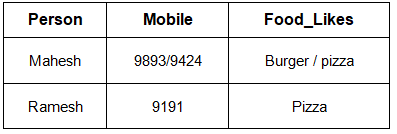
Person->-> mobile,
Person ->-> food_likes
This is read as “person multidetermines mobile” and “person multidetermines food_likes.”
Note that a functional dependency is a special case of multivalued dependency. In a functional dependency X → Y, every x determines exactly one y, never more than one.
Fourth normal form (4NF)
Fourth normal form (4NF) is a level of database normalization where there are no non-trivial multivalued dependencies other than a candidate key. It builds on the first three normal forms (1NF, 2NF and 3NF) and the Boyce-Codd Normal Form (BCNF). It states that, in addition to a database meeting the requirements of BCNF, it must not contain more than one multivalued dependency.
Properties: A relation R is in 4NF if and only if the following conditions are satisfied:
- It should be in the Boyce-Codd Normal Form (BCNF).
- the table should not have any Multi-valued Dependency.
A table with a multivalued dependency violates the normalization standard of Fourth Normal Form (4NK) because it creates unnecessary redundancies and can contribute to inconsistent data. To bring this up to 4NF, it is necessary to break this information into two tables.
Example: Consider the database table of a class whaich has two relations R1 contains student ID(SID) and student name (SNAME) and R2 contains course id(CID) and course name (CNAME).
Table – R1(SID, SNAME)

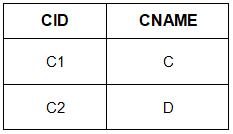
When there cross product is done it resulted in multivalued dependencies:
Table – R1 X R2
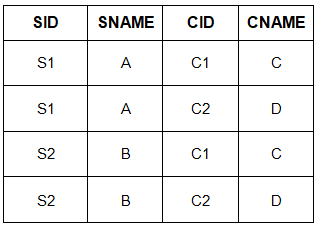 Multivalued dependencies (MVD) are:
Multivalued dependencies (MVD) are:
SID ->-> CID; SID ->-> CNAME; SNAME ->-> CNAME
Joint dependency: Join decomposition is a further generalization of Multivalued dependencies. If the join of R1 and R2 over C is equal to relation R then we can say that a join dependency (JD) exists, where R1 and R2 are the decomposition R1(A, B, C) and R2(C, D) of a given relations R (A, B, C, D). Alternatively, R1 and R2 are a lossless decomposition of R. A JD ⋈ {R1, R2, …, Rn} is said to hold over a relation R if R1, R2, ….., Rn is a lossless-join decomposition. The *(A, B, C, D), (C, D) will be a JD of R if the join of join’s attribute is equal to the relation R. Here, *(R1, R2, R3) is used to indicate that relation R1, R2, R3 and so on are a JD of R.
Let R is a relation schema R1, R2, R3……..Rn be the decomposition of R. r( R ) is said to satisfy join dependency if and only if
Example:
Table – R1
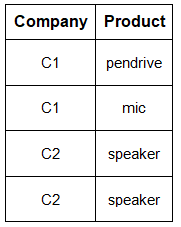
Company ->-> Product
Table – R2
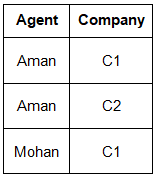
Agent ->-> Company
Table – R3
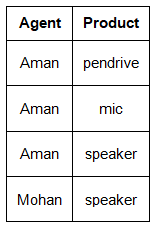
Agent ->-> Product
Table – R1 ⋈ R2 ⋈ R3
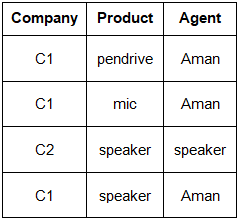
Agent ->-> Product
Fifth Normal Form / Projected Normal Form (5NF)
A relation R is in 5NF if and only if every join dependency in R is implied by the candidate keys of R. A relation decomposed into two relations must have loss-less join Property, which ensures that no spurious or extra tuples are generated, when relations are reunited through a natural join.
Properties: A relation R is in 5NF if and only if it satisfies following conditions:
- R should be already in 4NF.
- It cannot be further non loss decomposed (join dependency)
Example: Consider the above schema, with a case as “if a company makes a product and an agent is an agent for that company, then he always sells that product for the company”. Under these circumstances, the ACP table is shown as:
Table – ACP
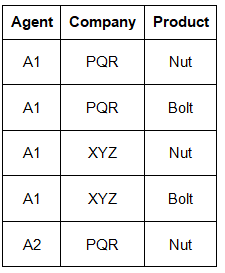
The relation ACP is again decompose into 3 relations. Now, the natural Join of all the three relations will be shown as:
Table – R1
 Table – R2
Table – R2
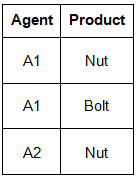
Table – R3
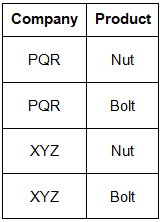
Result of Natural Join of R1 and R3 over ‘Company’ and then Natural Join of R13 and R2 over ‘Agent’ and ‘Product’ will be table ACP.
Hence, in this example, all the redundancies are eliminated, and the decomposition of ACP is a lossless join decomposition. Therefore, the relation is in 5NF as it does not violate the property of lossless join.
|
63 videos|93 docs|37 tests
|
FAQs on Introduction of 4th & 5th Normal Form - Database Management System (DBMS) - Computer Science Engineering (CSE)
| 1. What is the 4th Normal Form (4NF) in database design? |  |
| 2. What is the 5th Normal Form (5NF) in database design? |  |
| 3. How does 4th Normal Form (4NF) differ from 3rd Normal Form (3NF)? |  |
| 4. What are some benefits of achieving 5th Normal Form (5NF) in database design? |  |
| 5. Are there any drawbacks or challenges associated with implementing 4th and 5th Normal Forms (4NF and 5NF)? |  |
















